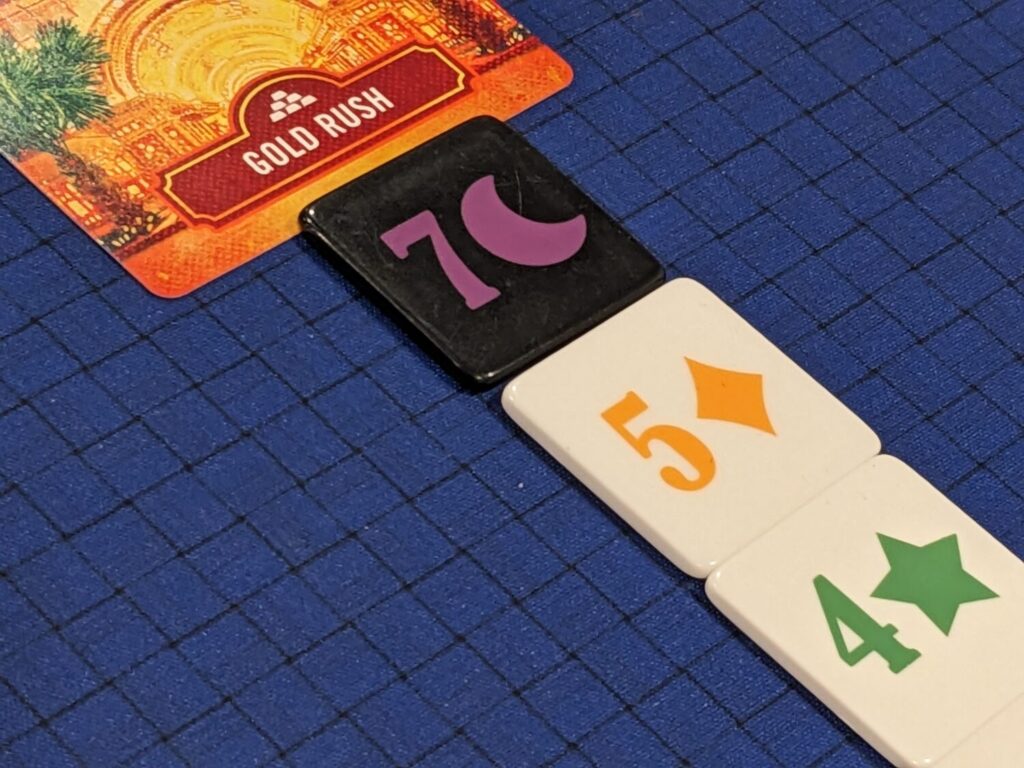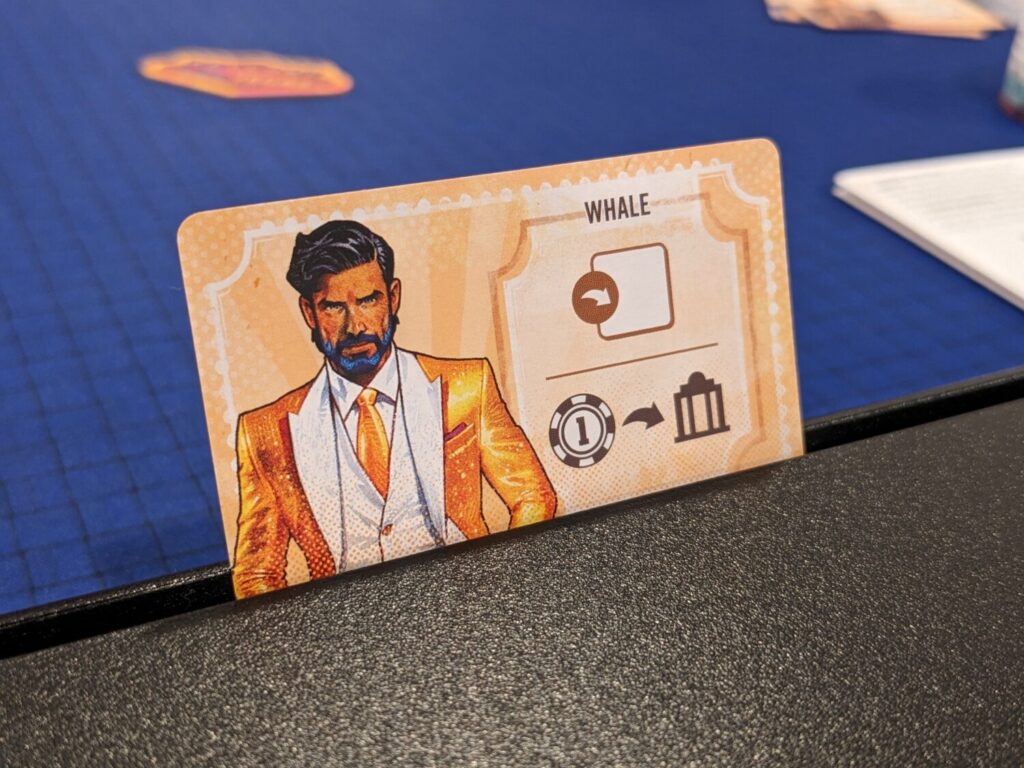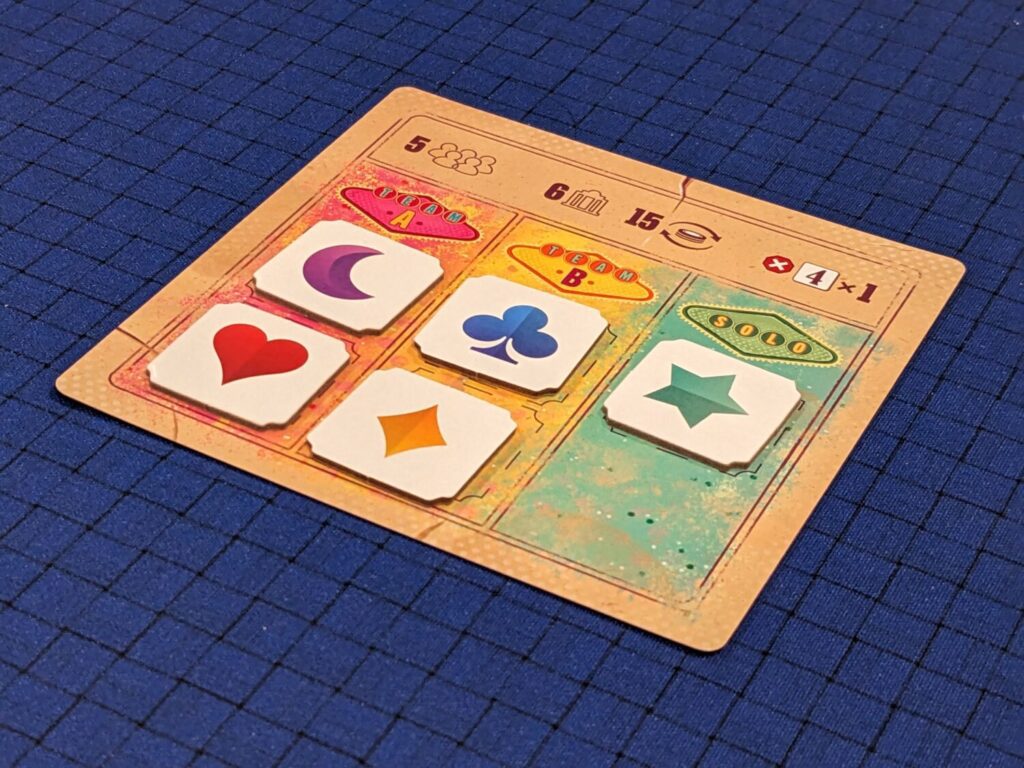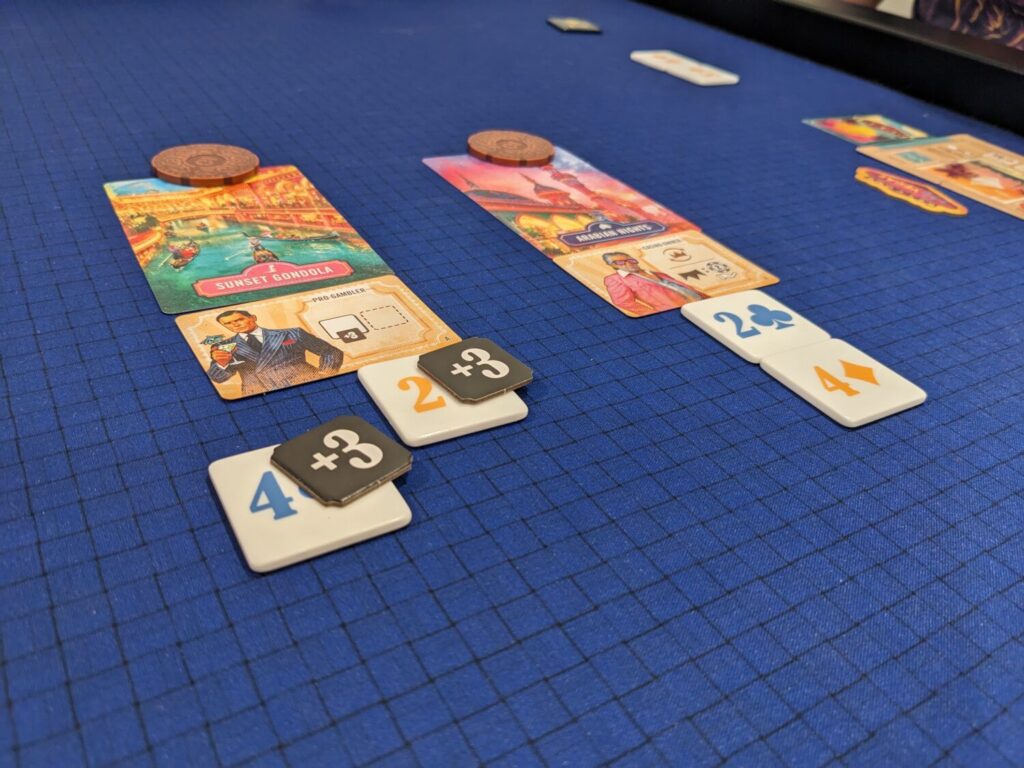Disclosure: Meeple Mountain received a free copy of this product in exchange for an honest, unbiased review. This review is not intended to be an endorsement.
Eyes were darting around the table. Something seemed fishy.
It was my second play of Vegas Strip (2025, Allplay), and in our five-player game, it was getting late in the second round. Players represent gamblers working alone or in teams to make the most money by gambling at a mix of six different casinos. Some of those casinos were rigged and others were secure, but each player has incomplete information: everyone knows one of the rigged casinos and one of the secure ones, but it’s a 50/50 guess regarding the other casinos in play.
Gideon was avoiding eye contact when I tried looking his way to see if he would give up a “tell” regarding what he knew. My partner, Wil, and I couldn’t talk during the round about what we knew and didn’t know, but there were a lot of side-eye glares shared during the round!
Vegas Strip has a lot of these moments, especially at higher player counts. I know this because I also tried Vegas Strip at three players…and I’ll cut to the chase by saying that Vegas Strip doesn’t shine as a game where three players are each playing solo.
It led one person to declare that Vegas Strip is a “six-player game, with player variants at five, four, and three players.” Now that I’ve seen the game in the wild, I have to agree.

Vincent DuStraight
Vegas Strip is a deduction game for 2-6 players, designed by Peter C. Hayward (That Time You Killed Me) and illustrated by Vincent Dutrait (hundreds of credits, but I loved his work on Unconscious Mind from 2024). I didn’t even try Vegas Strip at two players because I knew after my five-player game that Vegas Strip is not meant to be played at lower player counts.
Vegas Strip is a team deduction game for 2-6 players. BGG’s users think it plays best at four players, but I have a feeling Vegas Strip really plays best at six players.
Each of the game’s three rounds plays out the same way. Teams are assigned during the setup for each round, and players will have a different partner in each round (one captain, one associate). In a five-player game, there are two separate two-person teams and one solo player. Then, each team’s captain is dealt two casino cards, and has to secretly pick one of those as a rigged casino and the other as a secure casino. Then, that choice is shared with their partner.
That choice is important: at the rigged casino, only the person who plays the highest-value poker tiles at that casino (represented by large, square cards) will win the jackpot at that location.
At the secure location, everyone except the leader wins money equal to their poker tile value. That means that coming in high every time is guaranteed to only work at half of the casinos, so you’ll need to plan out your attack at each location.

On a turn, the active player places one of their poker tiles against any of the six casinos. Over the course of the round, as values shift by player, tiles are re-ranked so that the highest value chips by player are placed at the top. There are some other rules with tile placement–no one can place a tile that ends with two players being tied for the lead, and each player can only place a max of two of their own poker tiles at any single location.
The real juice with the game’s variable setup comes with the character cards. During setup, each casino is also assigned a character power. This changes the rules for poker tile placement in some interesting ways. The more basic characters entice players to place tiles to make a dollar or two. Others only allow certain poker tile numbers to be placed at a location. Others boost a location’s jackpot, while one power doubles the payout for each player if that location is secure.
There are 20 character powers in all, but only six are ever used in each game, max. The character powers alone have made my plays of Vegas Strip a blast, and sussing out which locations are rigged versus secure was fun.
After all players have placed all poker tiles, the rigged casinos are revealed and payouts are awarded to the highest-value poker tiles at those locations. At the secure locations, the leader is removed, then every other player gets paid. Solo players keep all winnings, while team players have to pool their winnings and split those winnings 50/50 with their partner that round.
After three rounds, the two highest-scoring players win the game. (I still don’t get why there are two winners in a game like this; it shouldn’t matter that partners shift from round to round. We quickly house-ruled this so that only the single player with the most money wins.)

Four or Six Players? Yes, Please
Vegas Strip got better as my games included more players. For that reason, I would recommend Vegas Strip as a four-, five-, or six-player game. At three players, each of whom is playing solo and where two of the three players are “winners”, I didn’t have as much fun gaming out the best ways to win (or, maybe, lose) at various casinos. The subtle table talk is just more interesting when you’ve got a partner. And because you are splitting the winnings, no one is trying to tank your team’s efforts.
I love the mechanics tied to not being able to tie the leader at a casino, and the limits of only two poker tiles at a casino per player. That made the decision space quite interesting late in each round. Combined with the rules for characters, each casino becomes its own mini puzzle.
Interestingly, one of my review crew members prefers to play deduction games like this one as a solo player, so he was the one person who did not enjoy Vegas Strip at higher player counts. I see the reasoning—if you don’t like to play partner games, Vegas Strip won’t be a fit in the team variant anyway. But he was the exception; the other four players who tried this game enjoyed themselves quite a bit.

There were a couple of things that didn’t work for us, regardless of player count. The only jackpots that reset between rounds are the ones at rigged casinos. At secure casinos, money is not added to those jackpots between rounds. I think it would be significantly more interesting to add more money to the secure casinos between rounds. If those become rigged in the next round, that could lead to a major payout. And in a bluffing game, who’s to say that this will happen? A huge pot might lead players to guess and lose out anyway.
It’s also fair to say that Vegas Strip has shades of a guessing game, versus a true deduction game. Look, each casino can only be one of two things, so in one of our games, players just went hard on a particular casino in the hopes that it happened to be a rigged location. If they were right, they got themselves a huge payout. In the team game, that almost feels like a strategy, with each player going after one of the casinos where they don’t have complete information.
I’m not sure how good it will feel if a player wins simply by guessing a few times in each round of a short game. I haven’t seen anyone pursue that strategy for an entire game yet, but I’m worried that it is a viable path.
Otherwise, Vegas Strip was a good time. It hasn’t topped games like Vabanque in my collection, but it’s a solid entry at higher player counts.











